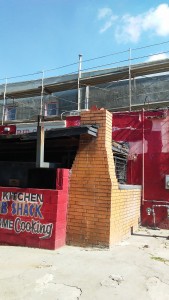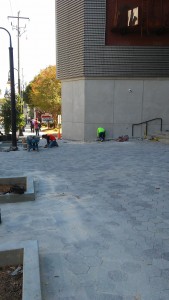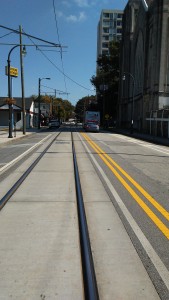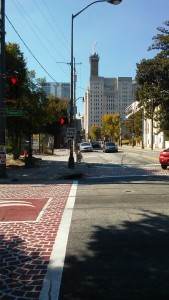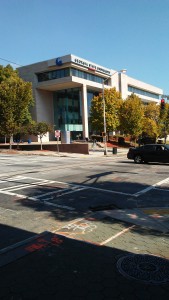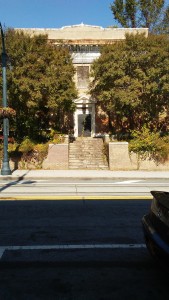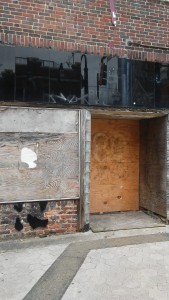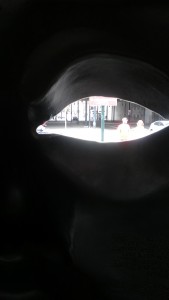Tall, beautiful, majestic, all words that come to mind when you first lay eyes on this architectural marvel. The buildings beautiful exterior eludes from its position along what would seem to be the more “underdeveloped” part of Auburn Avenue. When the building appears on the horizon, it gives off a sense of detachment. The sense only grows stronger as you move towards it, eventually seeing a clear and distinct perimeter surrounding the vicinity. The scenery changes, trees become more abundant, the smell of flowers permeate the air, as it does away with the previous smell of decay.
Category Archives: Built Environment Descriptions
Building Renovation
Nearly deserted, walking towards Thelma’s Kitchen and its immediate vicinity feels equivalent to walking alongside an alleyway. Located only a couple feet away from the highway, Thelma’s Kitchen is a relic of the past, and its existence seems to almost self-perpetuate its period. Its bright red brick walls stand out amongst its surroundings, making it the center of attention to any passerby. Right next to the shack, a building is undergoing renovations. The metal bars that strut upwards offers a unique view as pedestrians see for themselves the process of change occurring on the street of Sweet Auburn.
Street Renovations
Sounds of metal on metal echo out along the Avenue as workers lay down new tiles in place of old. Caution tape and working cones surround sections of the sidewalks as more extensive renovations are underway. The streets here, towards the upper end of Auburn Avenue, are under much more care than what you would see walking forward.
Street Disparity
Walking from Georgia State’s T deck to the intersection of its Honors College is an entirely different experience than the proceeding half of Auburn Avenue. Walking towards the Honors College is a breath of city life, the wind hits you, carrying with it a wide variety of smells coming from the numerous restaurants around, coupled with the smell of gasoline, accompanied by honking and sirens, and the sight of other pedestrians, it is the embodiment of city life. Walking the other stretch of the street, you will notice pretty quickly the difference in experience. The sounds change, the increasing sights of homelessness increase, cars, buildings, everything takes an almost 180-degree turn.
Building Disparity
The picture above juxtaposes two buildings, one being Georgia State’s Honors College, while the other, a run-down, abandoned building. The two are found side by side. The Honors College is adorned with modernism, its sharp edges, its cleanliness, the use of glass for natural light; everything about the building exudes an air that befits contemporary society. The building right next to it, however, is the epitome of difference; everything the Honors College is, it is not. Covered in what appears to be kudzu and a variety of other vegetation, the building, both in sight and smell, reek of decay.
BED Political
I stuck with Auburn Avenue (Sweet Auburn) once again as I found myself infatuated with both it’s cultural, as well as its political history. Located just a walk away from Down Town Atlanta, Sweet Auburn was and still is, the center for civil rights. The iconicity of the avenue goes unquestioned, as even to this day, movements such as “Black Lives Matter” take to the Avenue as their roots. Walking along the street you will see a variety of sights, ranging from modern buildings, to run down, abandoned, business. Sometimes, the two are situated right next to one another. The disparity between visuals bombards the entirety of the walk and will open the door to which a peek can be seen of the streets intricateness; albeit, one filled with ups and downs. The differing visuals and cues of the street hit you like a hurricane as you walk through what seems like the annals of time, experiencing both past and present. The sights and audio of the street all radiate black culture, which comes to no surprise as the street was once known as the most thriving black American business district in the U.S. By far a hollow husk of its former self, it continues to live on.
The street, despite its degradation, survives to this day mostly in part by the influences of politics. Auburn Avenue has a long history of political influence; it would not be false to say, that their present iconicity comes from extensive policies dealing with segregation way back when. Moving forward, civil rights leaders such as John Dobbs, the “unofficial mayor” of Auburn Avenue, worked closely with Mayor Hartsfield to provide to the street. His grandson, Maynard Jackson, who eventually became the mayor himself, also poured his efforts to the revitalization of the street. Auburn Avenue became what it was through politics. It is what it is today through the same politics. The Street is constantly changing, reshaping itself and redefining its presence, all due to the influence of politics. Changes show itself as you walk further along the road, it won’t take long before you chance upon areas where renovations are being done to what used to be old, run down buildings. These repairs represent the underlying politics that surrounds the Avenue as the city wishes to undergo an effort of revitalization. When walking around these areas, the sound, as well as the look, if only a minuscule amount, starts to change. Political decisions have shaped the built environment of the street for decades and will continue to do so in the coming times.
Auburn Avenue Cultural BED
Auburn Avenue, or better known as “Sweet Auburn,” was considered the capital of black American commerce during the early 20th century. The title, despite its glorious connotation, fails to mention the status in which the African-American community faced during such times. Restriction and segregation played a huge role in the establishment of this title, as it was through the limitations of black communities that resulted in their banding together and creating what was known as the greatest black American business district in the country. Heavily influenced by segregation, Auburn Avenue gave birth to one of the most influential minds in history, Dr. Martin Luther King Jr., a man whose actions and aspirations shaped the entire cultural fabric of the street. Once known as the most thriving black American business district, now is known for its role in the civil rights movement. The street still retains some of its previous images as an area of commerce, holding onto old remnants of former business such as the abandoned insurance building and the (still running) funeral house I documented. However, what seems to be most abundant, is the presence of Dr. King and his movement for civil equality.
Walking along the street you will see an array of murals, from paintings depicting leaders such as Congressman John Lewis, a staunch supporter of black American equality, to slogans and statues that embody the movement; the statue of John Dobbs being one such example. The cultural dynamic of the street revolves around the civil rights movement and everything it entailed. This notion presents itself throughout the entirety of the Avenue as there are endless amounts of artifacts that point towards the movement and its leaders, the dedication of Dr. Kings neighborhood as a national historic park is a prime example of how much the civil rights movement has impacted and shaped the street. In the video I took, it can clearly be seen that Dr. King’s neighborhood, now a historic center, does not detach itself from the street whatsoever, rather its easy access and connectivity to the rest of the street suggests a relation between the historic center and the Avenue. The cultural heritage left behind by Dr. King and others has shaped Auburn Avenue into what it is today. A straight path, Auburn Avenue is by no means a hard to navigate street, walking along which, I could not help but feel a sense of isolation, almost as if the Avenue itself belonged in an entirely different space. Which by no means entail the contrary, rather the separation serves as evidence of just how much its culture shaped the street, providing an entirely unique identity which discerns it from neighboring streets.
Road to Dr. King’s House
The video demonstrates the ever so present cultural interest people have towards Auburn Avenue. The video covers the area of Dr. King’s house, located within the King Historic Center District. The sheer volume of people present at the site attributes to the notion of the place being an area of historical importance. The area, having so many people visit, is a testament to which the cultural aspects of the location presents itself. Dr. King and the Civil Rights movement has had an immensely strong impact on the cultural heritage Sweet Auburn.
Presence of Building Decay
Sweet Auburn, once a thriving area for black commerce and living, is now a husk of its former self. The remnants of days past can be seen throughout the Avenue, as old business buildings, long abandoned, still, stand erect to this day. The buildings presences over the street allude to a more prosperous time; however, its presence in no way diminishes the cultural heritage of the street, if anything, it’s being provides an even more definite feeling of cultural importance. This building, along with others, allows the street to retain its past identity, keeping it from undergoing a complete gentrification.
Through the Eyes of John Dobbs
Looking through the eyes of John Dobbs, the “unofficial mayor” of Sweet Auburn, the entirety of the street can be seen. John Dobbs played a huge role in the perception of the Avenue, as he pushed legislation to be passed that would benefit the street and its community. The presence of Dobbs shaped the area to what it is today; an area of cultural importance to African American history. The statue, dedicated to Dobbs, points his sight towards the street, symbolizing his everlasting presence and the ongoing battle for equality.

